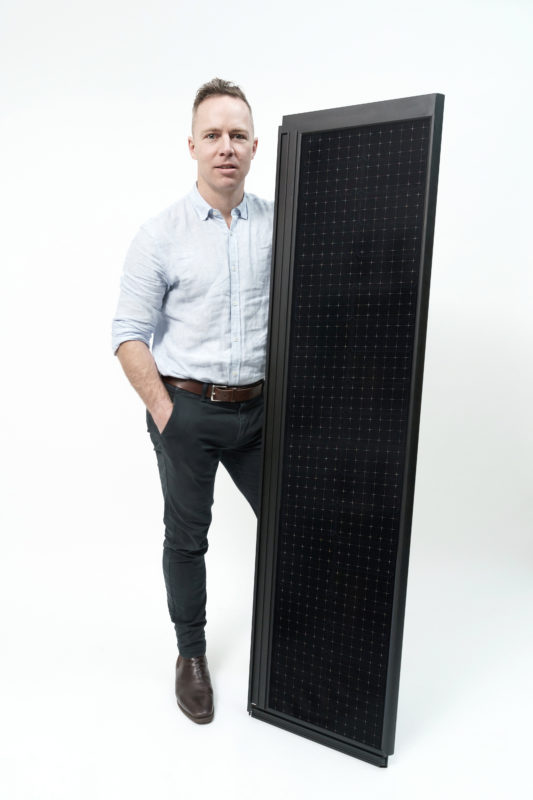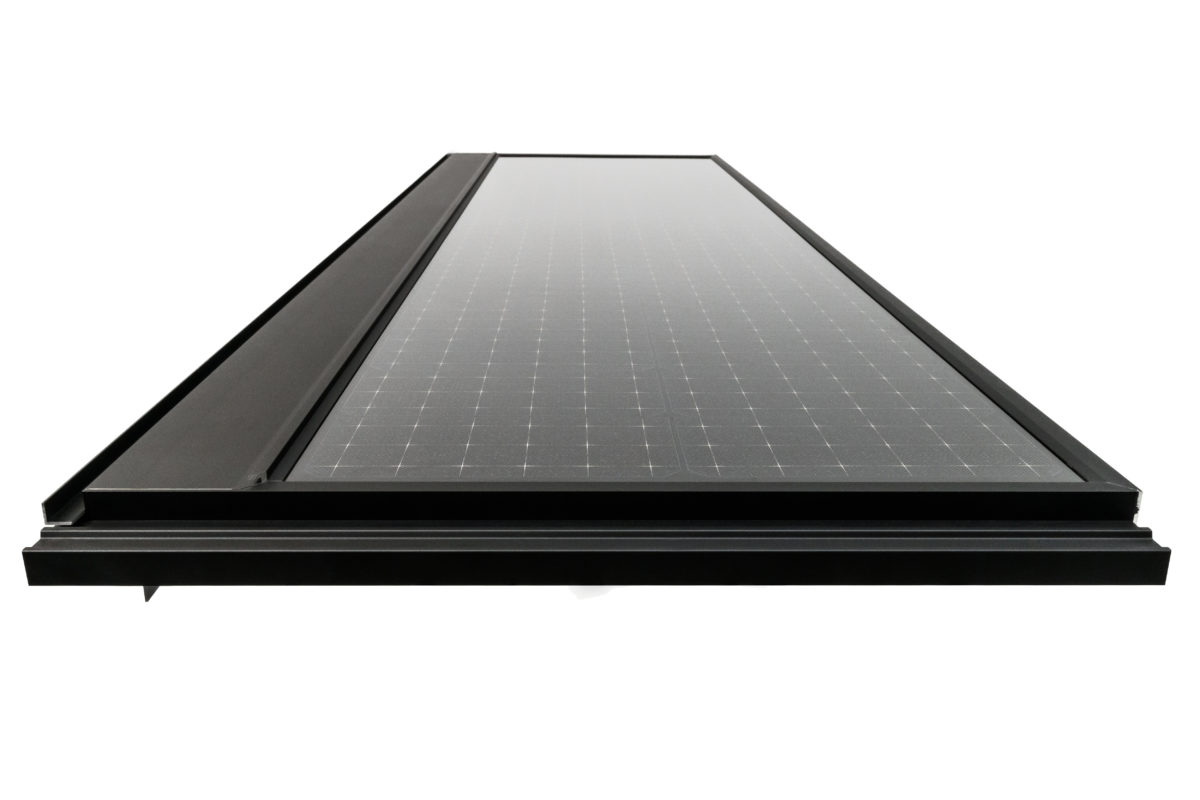On this drizzly Melbourne day, a roof within the city’s convention centre was showing a particularly sunny aspect. Volt, the first solar roof tile capable of generating energy equivalent to that produced by a standard solar panel roof tile, has been launched, with Clean Energy Council certification, at the CEC’s All-Energy conference and exhibition.
Hundreds of solar installers came to touch, feel and appreciate this new opportunity to crack the home market at build stage, and deliver what many customers have been asking for: solar PV that integrates seamlessly with the roof profile.
Volt has partnered with Bristile Roofing (part of the ASX-listed Brickworks group of companies) and Spain-based global roof tile provider La Escandella, to market its two high-efficiency tiles: the 115W Planum with an 18.8% solar-conversion efficiency, and the 105W Lodge tile offering 19.4% efficiency.
pv magazine Australia caught Peter Leeson, Managing Director, of Volt parent company, Leeson Group, proudly wedged between his roof tile displays in a booth at All-Energy, to learn a little more about this passion project, which took eight years to bring to fruition and is now poised for distribution and installation in some 86 countries including Australia.

Image: Leeson Group
pv magazine: What made you pursue the solar roof tile?
Peter Leeson: I’ve been in solar for 14 years. I’ve built a lot of homes and property developments and I saw the integration of PV into the roof structure as a critical part of the process in future. We’d done installations in Australia and in Southeast Asia and we quickly realised that facade solar doesn’t make sense. It’s inaccessible because it’s really high cost. Roof is the real estate. Some people are happy with panels, but we believe that in four to six years the majority of new homes will have integrated rooftop solar. It’s gaining traction globally and the Tesla Solar Roof has had a lot of attention.
We’ve now been developing our product for eight years, designing and redesigning it and getting it right. We also develop solar farms and as the revenue came from those projects we decided to get going. This week we installed our first Volt roof in Victoria. In coming weeks we’re installing in South Australia and Western Australia, and we’re about to install in Spain, in Barcelona.
Where are you manufacturing?
Right now we’re made in China on a 2GW fully automated manufacturing line. Later next year we’re going to set up a manufacturing plant for the frame extrusions, cutting and assembly in Australia, which is about 50% of the volume of the product, and about 50% of cost because it’s a really technical frame — that’s where all the IP is. Then in 2024 we’ll look at financial flows on building a local manufacturing line. That would allow us to produce a fully Australian-made solar tile from 2025.
So the solar panel is the roof tile. How does it work?
The solar tile is seven times as wide as the La Escandella terracotta roof tile, for example. So you start laying the roof tiles, then in any position that a solar tile will fit, you lay the solar tile, and then you frame the solar section with more roof tiles. So it’s fully integrated.
What’s the lifetime of the product?
Volt solar tiles have a 30-year performance warranty — the longest performance warranty of any solar tile product — and a 15-year product warranty, which is also the longest in this product category.
What gives you confidence in offering such long warranties?
Our manufacturing line. We’re using a 2GW fully automated line for MWT cells. These cells have a circuit board on the back; they’re placed onto a conductive back sheet; and it’s fully laminated in that process. There’s no manual handling.
Most other tile products are of an obscure size, but they’re produced on a standard line that typically makes 400W panels, so they have to go through a different process because manufacturers are not going to shut down the line, rebuild it to just do a small run of three megawatts of one product, and then run it back into the normal size of the laminant.
Having a dedicated line for this actual cell type, it’s all programmed. The machines place our 38 half-cut cells on the right-size glass — everything runs automatically. And we’ve got really good quality assurance. These factors allow us to give the long warranties.
And when the panel reaches the end of its life, can it stay on the roof as a roof tile?
It can. When you say at the end of its life, we’ve yet to see what a quality panel does at the end of its life. You could just leave ours in place, but that may not be the best solution. If you no longer want to generate electricity, you could replace Volt tiles with roof tiles. But if you want to upgrade, this size module now is 115 watts; in 30 years time, it’s probably going be 250 watts. There’ll be completely different technology, offering other opportunities.
What kind of demand are you anticipating for Volt?
Globally, we’re looking at about 6.6 MW in 2023. We’re distributing to 85 countries with La Escandella, and we also have our partnership program in Australia. We are partnering exclusively with 100 quality solar companies, and we’re going to train them in selling this solar. It’s the first opportunity any solar company in the country has had to sell BIPV.
As a solar company, you don’t need to have a roof license. For building you do. In our case, Bristile will come in and certify the roof as fully compliant, because they’ll be on site with the installation of the tiles. It’s a great opportunity for solar companies to be able to reach that new-build market and have a unique selling proposition. We think we’re going to scale really well.
The other key thing is that in the build process, generally speaking, you sell the solar tile system and it can be six months before you’re installing because they’ve got to put the slab down and build the frame to get it ready for the roof. Our software allows our partners, the solar companies, to click a button in our portal that will reserve that spot in the production process, lock in the price, and that automatically feeds into our manufacturing system.
Are the actual roof tiles only available in black?
The roof tiles are available in various colours but the solar tiles only come in black.
New South Wales now has a requirement that new builds have to have light-coloured roofs, to help reduce the heat island effect of high-density housing with many dark coloured roofs. How will this play out for Volt?
You can still do a light-coloured roof with our solar tiles. There’ve been a lot of queries about whether we can do white solar tiles, or orange solar tiles. The technology’s there and the cells are there, but they’re less efficient than the black solar tiles. So to get high performance for a mass market at an accessible price, we need to go with a standard product that can be manufactured in bulk. Changing colours messes with the volumes. In time, we will do colour. That’ll be the next generation, when we’re doing the printing ourselves.
What is Volt’s accessible price?
We’re a quarter the cost of the Tesla Roof, and half the price of the other competitors in the market. A 5kW Volt system costs $12,000 fully installed after STC rebates.
This content is protected by copyright and may not be reused. If you want to cooperate with us and would like to reuse some of our content, please contact: editors@pv-magazine.com.









By submitting this form you agree to pv magazine using your data for the purposes of publishing your comment.
Your personal data will only be disclosed or otherwise transmitted to third parties for the purposes of spam filtering or if this is necessary for technical maintenance of the website. Any other transfer to third parties will not take place unless this is justified on the basis of applicable data protection regulations or if pv magazine is legally obliged to do so.
You may revoke this consent at any time with effect for the future, in which case your personal data will be deleted immediately. Otherwise, your data will be deleted if pv magazine has processed your request or the purpose of data storage is fulfilled.
Further information on data privacy can be found in our Data Protection Policy.